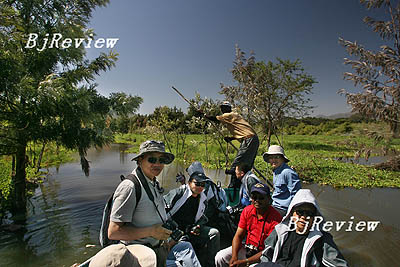|

Chinese scientists completed a grueling 20-day scientific expedition to the Great Rift Valley in Ethiopia and Kenya on December 27, 2007. The trip was aimed at collecting data on the area. It came about after the same team explored the Arctic in 2003, Amazon in 2004, Himalayas in 2007 and the Silk Road in Central Asia in 2007.
Invited by Addis Ababa University of Ethiopia, the 2007 Vcanland East African Great Rift Valley Scientific Exploration, which was jointly held by the Center for International Scientific Exchanges under the Chinese Academy of Sciences (CAS) and Tianjin-based Jinwan Media Group, was launched on December 8, 2007.
The team set out to find physical and chemical changes of the area, geological structures and geological process in the formation and evolution of the valley, the structural theory of the formation of the low-lying land surface, the valley's future changes and its influences on humans (such as volcanic eruptions, mud-rock flows and floods, and their influences on global climate changes), ecological changes around the valley and its global impacts, origin of humanity, and ways to promote China's further cooperation with Africa in this area.
Entering East Africa via Ethiopia, scientists started from the Afar Desert and Erta Ale Active Volcano, the north end of the Great Rift Valley in North Africa. This was the first time the Chinese have entered this region for scientific exploration on volcanic activity. According to Liu Jiaqi, Chief Scientist of the project who is also the academician of the Institute of Geology and Geophysics under the CAS, his team would systematically study the rock and soil samples and materials related to hydrology and climate changes, trying to complete China's first authoritative scientific report on the volcanic and geological changes, eco-environment and bio-diversification and relics of ancient human beings in the Great Rift Valley at an earlier date.
Important region
Liu noted that the formation of the Great Rift Valley is one of the world's most important geological events since the Cenozoic Era, and the area is currently one of the most active regions in the global geological structure. In recent years, the East African Great Rift Valley plate becomes active, attracting attentions from geologists worldwide. "The region is the ideal place to discuss important theories on geosciences and the future developing trend of the globe," Liu added.
According to Ethiopian scientists, the section in Ethiopia is the juncture of the African plate and Arabian plate, with several earthquakes and volcanic eruptions happening there from September 2005. In the past two years, many large rifts newly occurred in the region, with the largest stretching 60 km long and 8 meters wide. It shocked geology circles to see so large a rift within such a short period of time.
Meanwhile, the East African Great Rift Valley is one of the birthplaces of ancient men. Anthropologists discovered large quantities of ancient human fossils between 3.7 million and 700,000 years ago in the valley. These fossils are important materials to research the origin of human beings.
In this sense, Liu noted, scientific exploration to the East African Great Rift Valley is of great importance to studying geosciences, biology, environmentology and anthropology.
A new continent?
The East African Great Rift Valley came into being some 20 million years ago when the crustal movement of Africa and Asia formed a crustal rift from the east part of Africa to the southwest part of Asia. It is the world's longest rift. Statistics of crustal movement and volcanic activities in recent years indicate that the rift is accelerating its widening in easterly and westerly directions.
"The Red Sea was actually formed by the separation of Asian and African geological structural plates. It is still a controversial topic whether East Africa can give birth to the eighth continent and the fifth ocean," said Liu. According to the scientist who has studied volcanoes all his life, this is not likely to happen.
Besides the East African Great Rift Valley, there are still other similar rifts such as the great rift in Nevada State of the United States. The Songnen Plain in northeast China used to be a great rift too. "The two rifts are much older than the East African Great Rift Valley, but they did not create new continents or oceans," said Liu. But as one of the youngest geological region with the most active geological movement, the East African Great Rift Valley will continue to be under the close watch of scientists worldwide.
Stretching human history
There is still no final conclusion on the issue of the origin of the human
| 